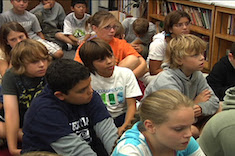Some years back, I was reading a book aloud to my seventh graders. We weren’t yet to the halfway point, and I was happily enjoying the whole thing—I loved the book, and I loved the discussions I knew we would have at each pivotal point in the text. I didn’t even mind reading the same passages five times each day as I strove to keep each of my five classes in line with one another. I was doing it right, by golly. I had a good book, I was reading it aloud with the right pace and cadence, and we were doing it in lockstep. That was good teaching.
But as I worked through the beginning chapters of the book, something felt off. I was finding that the discussion topics I’d planned didn’t seem as riveting to my students as I’d thought they would be. When I asked them questions about the text, their answers lacked luster and spark. Their comprehension was passable, but I didn’t see deep thinking or reflection going on. And they certainly weren’t showing the empathy and connections I’d anticipated the text would inspire.
It will come, I told myself, and forged ahead.
But then, one day, as I was settling down to read to my first-period class, I heard an audible sigh from one of my students. I looked up at him. He averted his eyes. “What’s wrong?” I asked him.
He shrugged.
“What? Don’t you like this book?”
He looked down at his lap. I shifted my gaze to the class as a whole. “What about the rest of you? Do you like this book?”
No one moved.
“Seriously, guys. I love this book! Don’t you? Don’t you love it?”
Twenty-five pairs of eyes moved to 25 laps.
“Raise your hand if you’re enjoying this,” I said.
All hands stayed down.
Surprised and—yes—a little hurt, I told them sharply that we were going to keep reading. There was a lot to think about in this text, I explained; the characters were complex and were grappling with really important stuff. “We’re going to think about the contrasts between their experiences and the experiences you are having in your own lives. And we’re going to use this text as a springboard into our opinion writing unit,” I explained. We’ll forge ahead, I thought. They’ll learn about perseverance, and they’ll come to love this book like I do.
They dutifully listened as I read through the day’s allotted pages. When the bell rang, they picked up their belongings and moved on to another class.
I asked the students in my next period if they were enjoying the book. Same response. And the next period, too, and the two after that.
That evening, I thought a lot about it. I couldn’t believe they weren’t more enthusiastic. This is an excellent book! An applicable book! I love this book! What is going wrong?
And then I had this thought: What if, maybe, this book isn’t very likable to my students? Maybe it’s likable to me, a 30-something woman who is a teacher of teenagers, because it makes me feel like I understand the teen experience . . . but maybe it doesn’t really represent the teen experience at all.
I came face-to-face with an important realization: Although it’s really nice when a book can speak to both young readers and their teachers, it doesn’t always happen. And it’s foolish to force it.
So I stopped. The next day, I admitted to my class that I had been dragging them along on a reading journey that they weren’t enjoying on any level. I told them that any of them could continue the text on their own, but I wouldn’t force-feed it to them as a group. We’d work to select a different text—one of their choosing, and one that would speak to them individually. I turned it into a bit of a joke, teasing them about the courage it took to openly dislike my book choice. “But it worked—I’m not going to keep reading this to you, because you obviously hate every word of it,” I said. “You win. Let’s move on.”
Their relief was palpable . . . and humbling.
We did move on. We found several other books that we all enjoyed, and our conversations were meaningful and productive. We found lots of connections in the new books, and we had a fantastic springboard into our opinion writing. Everything ended well.
But I’ve remembered it ever since—the moment when I realized I was forcing my students to endure a text they all disliked. It made me do a lot of thinking about the amount of power a reading teacher holds—because of the books we expose our students to, of course, but also because we have the ability to make decisions about when to force completion of a text or when to veer off in a different direction. As with any position of power, we have to be careful not to abuse it and instead apply it in ways that serve our students well.






